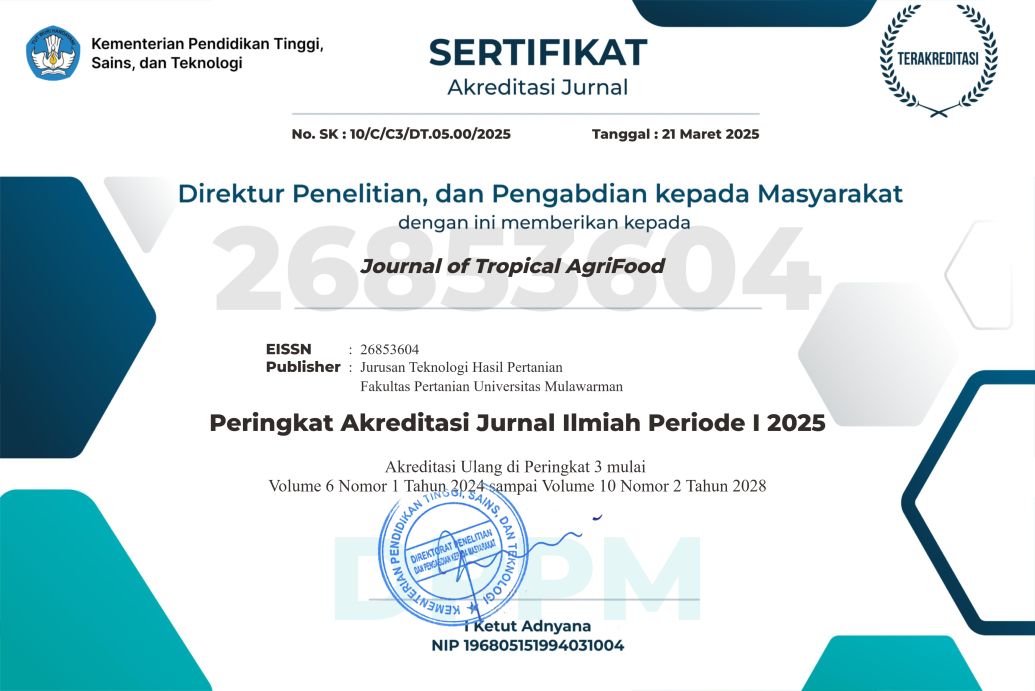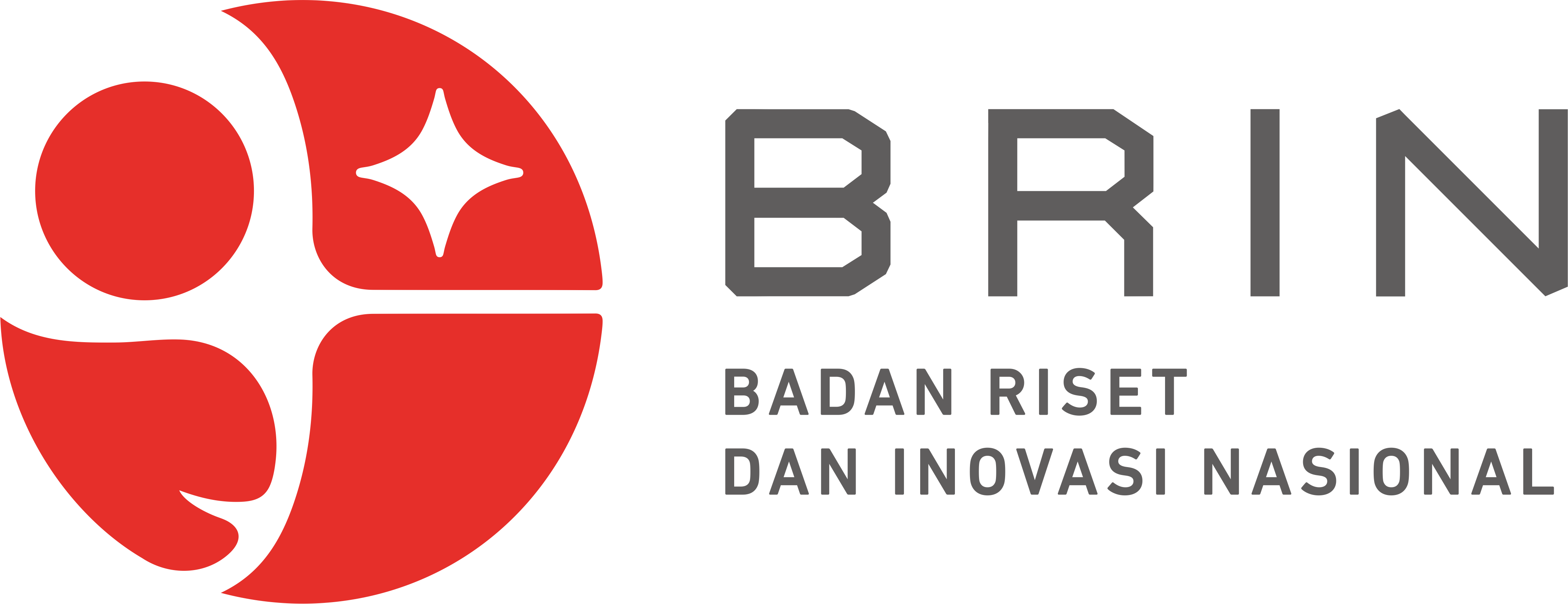Review singkat: Potensi antioksidan dari serbuk sari lebah
Abstract
Keywords
Full Text:
PDFReferences
Adaškevičiūtė, V., Kaškoniene, V., Kaškonas, P., Barˇcauskaite, K., Maruška, A., 2019. Comparison of physicochemical properties of bee pollen with other bee products. Biomolecules, 9(819): 1-22. doi:10.3390/biom9120819
Akhir, R.A., Bakar, M.F., Sanusi, S.B., 2017. Antioxidant and antimicrobial activity of stingless bee bread and propolis extracts. The 2nd International Conference on Applied Science and Technology. 1891, pp. 020090-1–020090-7. Johor: AIP Publishing. doi:10.1063/1.5005423
Aleksieva, K., Mladenova, R., Solakov, N., Loginovska, K., 2021. EPR analysis of free radical components and antioxidant activity of bee pollen before and after gamma irradiation. Journal of Radioanalytical and Nuclear Chemistry, 327: 713–719.
Almeida, J.D., dos Reis, A.S., Heldt, L.F., Pereira, D., Bianchin, M., de Moura, C., Carpes, S.T., 2017. Lyophilized bee pollen extract: A natural antioxidant source to prevent lipid oxidation in refrigerated sausages. LWT-Food Science and Technology, 76: 299-305. doi:10.1016/j.lwt.2016.06.017
Altiner, D. D., Altunatmaz, S. S., Sabuncu, M., Aksu, F., Sahan, Y., 2021. In-vitro bioaccessibility of antioxidant properties of bee pollen in Turkey. Food Science and Technology, 41(1): 133-141. doi:10.1590/fst.10220
Anjos, O., Paula, V., Delgado, T., & Estevinho, L., 2019. Influence of the storage conditions on the quality of bee pollen. Zemdirbyste-Agriculture, 106(1): 87-94. doi:10.13080/z-a.2019.106.012
Arung, E.T., Syafrizal, Wijaya, I.K., Paramita, S., Amen, Y., Kim, Y.U., Shimizu, K., 2023. Antioxidant, anti-inflammatory and anti-acne activities of stingless bee (Tetragonula biroi) propolis. Fitoterapia, 164(105375), 1-5. doi:10.1016/j.fitote.2022.105375
Barbieri, D., Gabriele, M., Summa , M., Colosimo , R., Leonardi, D., Domenici, V., Pucci, L., 2020. Antioxidant, nutraceutical properties, and fluorescence spectral profiles of bee pollen samples from different botanical origins. Antioxidants, 9(10): 1-15. doi:10.3390/antiox9101001
Bayram, N.E., 2021. Vitamin, mineral, polyphenol, amino acid profle of bee pollen from Rhododendron ponticum (source of “mad honey”): nutritional and palynological approach. Journal of Food Measurement and Characterization, 15: 2659–2666. doi:10.1007/s11694-021-00854-5
Belina-Aldemita, M., Opper, C., Schreiner, M., D'Amico, S., 2019. Nutritional composition of pot-pollen produced by stingless bees (Tetragonula biroi Friese) from the Philippines. Journal of Food Composition and Analysis, 82: 1-8. doi:10.1016/j.jfca.2019.04.003
Carneiro, A.L., Pinto, A.C., Gomes, A.A., da Silva, L.A., Teixeira, M.F., Gomes, C.C., Naiff, M.D., 2019. Antimicrobial and Larvicidal activities of stingless bee pollen from Maues, Amazonas, Brazil. Bee World, 96(4): 98-103. doi:10.1080/0005772X.2019.1650564
Carpes, S., de Alencar, S., Cabral, I., Oldoni, T., Mourao, G., Haminiuk, C., Masson, M., 2014. Polyphenols and palynological origin of bee pollen of Apis mellifera L. from Brazil. Journal of Food, 11(2): 150–161. doi:10.1080/19476337.2012.711776
Chantarudee, A., Phuwapraisirisan, P., Kimura, K., Okuyama, M., Mor, H., Kimura, A., Chanchao, C., 2012. Chemical constituents and free radical scavenging activity of corn pollen collected from Apis mellifera hives compared to floral corn pollen at Nan, Thailand. BMC Complementary and Alternative Medicine, 12(45): 1-12.
De-Melo, A., Estevinho, L., Moreira, M., Delerue-Matos, C., de Freitas, A.D., Barth, O.M., de Almeida-Muradian, L.B., 2018. Phenolic profile by HPLC-MS, biological potential, and nutritional value of a promising food: Monofloral bee pollen. Journal of Food Biochemistry, e12536: 1-21. doi:10.1111/jfbc.12536
Denisow, B., Denisow-Pietrzyk, M. 2016. Biological and therapeutic properties of bee pollen: a review. Journal Science Food Agric, p.7. doi:10.1002/jsfa.7729
Fadzilah, N.H., Jaapar, M.F., Jajuli, R., Omar, W., 2017. Total phenolic content, total flavonoid and antioxidant activity of ethanolic bee pollen extracts from three species of Malaysian stingless bee. Journal of Apicultural Research, 56(2): 130–135. doi:10.1080/00218839.2017.1287996
Fatrcová-Šramková, K., Nôžková, J., Kačániová, M., Máriássyová, M., Rovná, K., Stričík, M., 2013. Antioxidant and antimicrobial properties of monofloral bee pollen. Journal of Environmental Science and Health. Journal of Environmental Science and Health, 48: 133–138. doi:10.1080/03601234.2013.727664
Freire, K.R., Lins, A.C., Dórea, M.C., Santos, F.A., Camara, C.A., Silva, T.M., 2012. Palynological origin, phenolic content, and antioxidant properties of honey bee collected pollen from Bahia, Brazil. Molecules, 17(2): 1652-1664. doi:10.3390/molecules17021652
Friedle, C., D’Alvise, P., Schweikert, K., Wallner, K., Hasselmann, M., 2021. Changes of microorganism composition in fresh and stored bee pollen from Southern Germany. Environmental Science and Pollution Research, 28: 47251–47261. doi:10.1007/s11356-021-13932-4
Gomes, A.N., Camara, C.A., Sousa, A.D., dos Santos, F.d., Filho, P.D., Dorneles, G.P., Silva, T.S., 2021. Chemical composition of bee pollen and leishmanicidal activity of rhusflavone. Revista Brasileira de Farmacognosia, 31: 176-183. doi: 10.1007/s43450-021-00130-z
Hemmami, H., Seghir, B.B., Ali, M.B., Rebiai, A., Zeghoud, S., Brahmia, F., 2020. Phenolic profile and antioxidant activity of bee pollen extracts from different regions of Algeria. Ovidius University Annals of Chemistry, 31(2): 93-98. doi:10.2478/auoc-2020-0017
Kacˇániová, M., Rovná, K., Arpášová, H., Hleba, L., Petrová, J., Hašcˇík d, P., Stricˇík, M., 2013. The effects of bee pollen extracts on the broiler chicken’s gastrointestinal microflora. Research in Veterinary Science, 95(1): 34-37. doi: /10.1016/j.rvsc.2013.02.022
Kalaycıoğlu, Z., Kaygusuz, H., Döker, S., Kolaylı, S., Erim, F., 2017. Characterization of Turkish honeybee pollens by principal component analysis based on their individual organic acids, sugars, minerals, and antioxidant activities. LWT, 84: 402-408. doi:10.1016/j.lwt.2017.06.003
Kanar, Y., Mazı, B.G., 2019. Efect of diferent drying methods on antioxidant characteristics of bee-pollen. Journal of Food Measurement and Characterization, 13: 3376-3386. doi:10.1007/s11694-019-00283-5
Karabagias, I.K., Karabagias, V.K., Karabournioti , S., Badeka, A.V., 2021. Aroma identifcation of Greek bee pollen using HS SPME/GC–MS. European Food Research and Technology, 247: 1781–1789. doi:10.1007/s00217-021-03748-4
Karapetsas, A., Voulgaridou, G.-P., Konialis, M., Tsochantaridis, I., Kynigopoulos, S., Lambropoulou, M., Pappa, A., 2019. Propolis extracts inhibit UV-induced photodamage in human experimental in vitro skin models. Antioxidants, 8(125): 1-20. doi:10.3390/antiox8050125
Khongkarat, P., Ramadhan, R., Phuwapraisirisan, P., Chanchao, C., 2021. Screening and bioguided fractionation of Mimosa pigra L. bee pollen with antioxidant and anti-tyrosinase activities. Journal of Apicultural Science, 65(1): 71-83. doi:10.2478/jas-2021-0001
Kostić, A.Ž., Milinčić , D.D., Nedić, N., Gašić , U.M., Trifunović, B.Š., Vojt, D., Pešić, M.B., 2021. Phytochemical profile and antioxidant properties of bee-collected artichoke (Cynara scolymus) pollen. Antioxidants, 10(7): 1091. doi:10.3390/antiox10071091
Kostić, A.Z., Milinčić, D.D., Tešić, Ž.L., Pešić, M.B. 2022. Bee pollen in cosmetics: The chemical point of view. In Boyacioglu, D. (Ed.), Bee Products and Their Applications in the Food and Pharmaceutical Industries (pp. 261-282). Belgrade, Serbia: Elsevier Inc. doi:10.1016/B978-0-323-85400-9.00011-3
Li, P., Yin, Z.-Q., Li, S.L., Huang, X.J., Ye, W.C., Zhang, Q.W., 2014. Simultaneous determination of eight flavonoids and pogostone in pogostemon cablin by high performance liquid chromatography. Journal of Liquid Chromatography & Related Technologies, 37: 1771–1784. doi:10.1080/10826076.2013.809545
LeBlanc, B.W., Davis, O., Boue, S., DeLucca, A., Deeby, T., 2009. Antioxidant activity of Sonoran Desert bee pollen. Food Chemistry, 115: 1299–1305. doi:10.1016/j.foodchem.2009.01.055
Mărgăoan, R., Stranț, M., Varadi, A., Topal, E., Yücel, B., Cornea-Cipcigan, M., Vodnar, D., 2019. Bee collected pollen and bee bread: Bioactive constituents and health benefits. Antioxidants, 8(12): 568. doi:10.3390/antiox8120568
Martinello, M., Mutinelli, F., 2021. Antioxidant activity in bee products: A review. Antioxidants, 10(1): 71. doi:10.3390/antiox10010071
Mazurek, S., Szostak, R., Kondratowicz, M., Wegli ´nska, M., Kita, A., Nems, A., 2021. Modeling of antioxidant activity, polyphenols and macronutrients content of bee pollen applying solid-state 13C NMR spectra. Antioxidants, 10(7): 1123. doi:10.3390/antiox10071123
Mohammad, S.M., Mahmud-Ab-Rashid, N.K., Zawawi, N., 2021. stingless bee-collected pollen (bee bread): Chemical and microbiology properties and health benefits. Molecules, 26(4): 957. doi:10.3390/molecules26040957
Mohdaly, A.A., Mahmoud, A.A., Roby, M.H., Smetanska, I., Ramadan, M.F., 2013. Phenolic extract from propolis and bee pollen composition, antioxidant and antibacterial activities. Journal of Food Chemistry, 39: 538–547. doi:10.1111/jfbc.12160
Morais, M., Moreira, L., Feás, X., Estevinho, L.M., 2011. Honeybee-collected pollen from five Portuguese Natural Parks: Palynological origin, phenolic content, antioxidant properties and antimicrobial activity. Food Chem Toxicol, 49(5): 1096-1101. doi: 10.1016/j.fct.2011.01.020
Nascimento, A., Luz Jr, G., 2018. Bee pollen properties: uses and potential pharmacological applications-a review. Analytical & Pharmaceutical Research, 7(4): 513-515. doi:https://doi.org/10.15406/japlr.2018.07.00276
Oyarzún, J.E., Andia, M.E., Uribe, S., Pizarro, P.N., Núñez, G., Montenegro, G., Bridi, R., 2021. Honeybee pollen extracts reduce oxidative stress and steatosis in hepatic cells. Molecules, 26(1): 6. doi:10.3390/molecules26010006
Özcan, M.M., Aljuhaim, F., Babiker, E.E., Uslu, N., Ceylan, D.A., Ghafoor, K., Alsawmah, O.N., 2019. Determination of antioxidant activity, phenolic compound, mineral contents and fatty acid compositions of bee pollen grains collected from different locations. J. Apic. Sci, 63(1): 69-79. doi:10.2478/JAS-2019-0004
Pérez-Pérez, E., Sulbarán-Mora, M., Barth, O. M., Massaro, C.F., Vit, P., 2018. Bioactivity and botanical origin of Austroplebeia and Tetragonula Australian pot-pollen. In Vit, P., Pedro, S., Roubik, D. Pot-Pollen in Stingless Bee Melittology (pp. 377-390). Venezuela: Springer, Cham. doi:10.1007/978-3-319-61839-5_27
Ramadan, M.F., 2013. Healthy blends of high linoleic sunflower oil with selected cold pressed oils: Functionality, stability and antioxidative characteristics. Ind. Crops Prod, 43: 65–72. doi:10.1016/j.indcrop.2012.07.013
Rocchetti, G., Castiglioni, S., Maldarizzi, G., Carloni, P., Lucini, L., 2018. UHPLC-ESI-QTOF-MS phenolic profiling and antioxidant capacity of bee pollen from different botanical origin. International Journal of Food Science and Technology, 1-12. doi:10.1111/ijfs.13941
Rodríguez-González, I., Ortega-Toro, R., Díaz, C., 2018. Influence of microwave- and ultrasound-assisted extraction on bioactive compounds from pollen. Contemporary Engineering Sciences, 11(34): 1669-1676. doi:10.12988/ces.2018.84165
Roubik, D., Patiño, J.E., 2018. The stingless honey bees (Apidae, Apinae: Meliponini) in Panama and pollination ecology from. In cham, In Pot-Pollen in Stingless Bee Melittology (pp. 47-66). Switzerland: Springer International Publishing. doi:10.1007/978-3-319-61839-5_1
Saputra, S.H., Saragih, B., Kusuma, I.W., Arung, E.T., 2021. Antioxidant and antibacterial screening of honey of Hiterotrogona itama collected from differents meliponiculture areas in East Kalimantan, Indonesia. Nusantara Bioscience, 13(2): 232-237. doi:10.13057/nusbiosci/n130213
Silva, T.M., Camara, C., Lins, A.C., Agra, M., Silva, E.M., Reis, I.T., Freitas, B.M., 2009. Chemical composition, botanical evaluation and screening of radical scavenging activity of collected pollen by the stingless bees Melipona rufiventris (Uruçu-amarela). Annals of the Brazilian Academy of Sciences, 81(2): 173-178.
Sindhi, V., Gupta, V., Sharma, K., Bhatnagar, S., Kumari, R., Dhaka, N., 2013. Potential applications of antioxidants – A review. Journal of Pharmacy Research, 7(9): 828-835. doi:10.1016/j.jopr.2013.10.001
Soares de Arruda, V.A., Vieria dos Santos, A., Sampaio, D.F., Araújo, E.d., Peixoto, A.L., Estevinho, L.M., Bicudo de Almeida-Muradian, L., 2020. Brazilian bee pollen: phenolic content, antioxidant properties and antimicrobial activity. Journal of Apicultural Research, 1-9. doi:10.1080/00218839.2020.1840854
Sousa, C., Moita, E., Valentao, P., Fernandes, F., Monteiro, P., Andrade, P., 2015. Effects of colored and noncolored phenolics of Echium plantagineum L. bee pollen in Caco 2 cells under oxidative stress induced by tert-butyl hydroperoxide. Agricultural and food Chemistry 63(7): 2083-2091. doi:10.1021/jf505568h
Su, J., Yang, X., Lu, Q., Liu, R., 2020. Antioxidant and anti-tyrosinase activities of bee pollen and identification of active components. Journal of Apicultural Research, 60(2): 297-307 doi:10.1080/00218839.2020.1722356
Tutun, H., Kaya, M.M., Usluer, M.S., Kahraman, H.A., 2021. Bee pollen: Its antioxidant activity. Uludag Bee Journal, 21(1): 119-131. doi:10.31467/uluaricilik.896045
Wu, W., Wang, K., Qiao, J., Dong, J., Li, Z., Zhang, H., 2018. Improving nutrient release of wall-disruption bee pollen with a combination of ultrasonication and high shear technique. J Sci Food Agric, 99: 564–575. doi:10.1002/jsfa.9216
Zhang, Q.W., Lin, L.G., & Ye, W.C. (2018). Techniques for extraction and isolation of natural products: a comprehensive review. Chinese Medicine, 13(20): 2-26. doi:10.1186/s13020-018-0177-x
Zhang, Y., Yang, F., Jamali, M. A., Peng, Z., 2016. Antioxidant enzyme activities and lipid oxidation in rape (Brassica campestris L.) bee pollen added to salami during processing. Molecules, 21(11): 1439. doi:10.3390/molecules21111439
DOI: http://dx.doi.org/10.35941/jtaf.5.1.2023.9861.1-12
Refbacks
- There are currently no refbacks.

This work is licensed under a Creative Commons Attribution-ShareAlike 4.0 International License.
| ||
This journal is jointly published by Agricultural Products Technology Department, Mulawarman University, Indonesia and Indonesian Association of Food Technologist (PATPI) Kalimantan Timur. JTAF Today Visitors Copyright © 2025 Universitas Mulawarman Provide by e-Journal System Portal Center of Excelllence for Tropical Studies and Manage by Wisanggeni |








